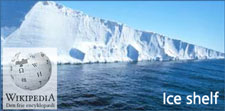New generation ESA-satellites capable of revealing future sea level rises
NEGIS, the Northeast Greenland Ice Stream, splits into three gigantic glaciers - holding back ice masses equaling a global sea level rise of approx. one meter. Higher temperatures due to climate change may affect NEGIS in the future. The dynamics behind such changes can be monitored via satellite images.
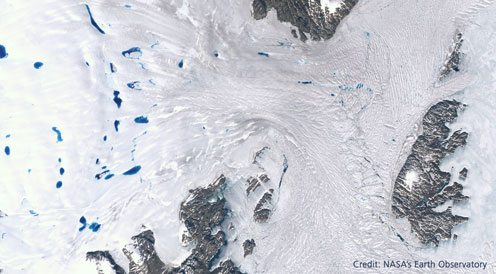
Satellite photo of Zachariae Ice Stream, Northeast Greenland. This photo was taken in the spring. The blue spots are melt water lakes, the grey spots are mountains. Photo: NASA
Over the past few years the calving from Zachariae Glacier in Northeast Greenland has accelerated rapidly – to an annual loss of mass equaling 5 billion ton. The new generation satellites from European Space Agency (ESA) reveal mechanisms behind this loss taking place in a vast area covering 16 percent of the Greenlandic ice cap.
This area is holding back ice masses equaling a global sea rise of approx. one meter were it all to melt – and the ESA satellites can help reveal how ice cap mass loss from this area will be affected by higher temperatures due to future climate change.
In a scientific article published in Geophysical Research Letters, a group of researchers led by scientists from Niels Bohr Institute (NBI), University of Copenhagen, Denmark, identify mechanisms behind the current loss of mass from NEGIS.
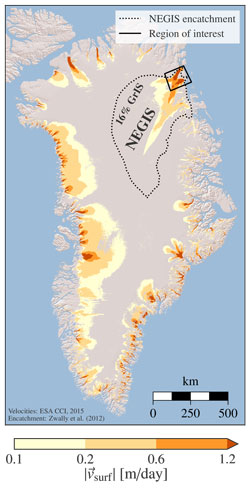
The scientists examined two NEGIS glaciers – Nioghalvfjerdsfjorden and Zachariae Ice Stream. The NEGIS perimeter is indicated by the dotted line. The bold square indicates the research area.)
In order to identify control mechanisms in the NEGIS region, the scientists – working as part of the European ice2ice project – compared a number of satellite photos of the area. The photos were taken over a period of one year - with intervals of 12 days – which provided the scientists with 30 ‘sets’ of images thereby making it possible to monitor closely on a month over month basis the progression in surface flow speed in the NEGIS region.
Two types of glaciers
Zachariae Ice Stream and Nioghalvfjerdsfjorden – the glaciers which the scientists studied – both debouch into the sea.
Nioghalvfjerdsfjorden-glacier is characterized by a 76 kilometer long ice shelf possibly functioning as a ‘cork’ – thus preventing loss of land based ice. Furthermore Nioghalvfjerdsfjorden-glacier sits on a potentially ‘adhesive’ underground which may also help reduce mass loss from the glacier.
Zachariae Ice Stream has no ice shelf, but at the mouth of the glacier it has a seasonal mélange - a ‘soup’ of sea ice and fragments of land based icebergs. This mélange can to a limited extent function as a ‘cork’ – but will, contrary to the ice shelf at Nioghalvfjerdsfjorden, give in during the summer and start dissolving when the melting season begins.
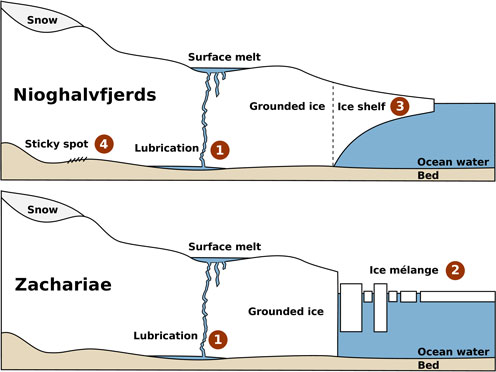
The right hand section of the drawings shows the major difference between the two types of glaciers: Nioghalvfjerdsfjorden has a long, floating ice shelf - where as Zachariae Ice Stream-glacier has a large seasonal mélange. The red dots indicate the four control mechanisms. 1: Lubricant. 2: Ice mélange. 3: Ice shelf. 4: ‘Adhesive’.
Atmospheric temperature rises
By combining information generated via atmospheric computer modeling and models describing ice flow patterns, the scientists were able to show that the extent to which NEGIS will contribute to future global sea level rises is particularly sensitive to the effects of atmospheric warming.
When the NEGIS surface is heated, snow and ice will melt and water will trickle down to the underground through cracks in the ice –a process, where water functions as a ‘lubricant’. This allows the ice to move – glide – on top of the firm underground, which in itself may lead to an increase in mass loss.
The models and the month over month measurements of surface flow-speed also raise a number of questions regarding the ‘cork’ effect created by the ice mélange in terms of limiting loss of mass; a mechanism still poorly understood.
The scientists furthermore emphasize the importance of looking into local control mechanisms regulating glacier mass loss when trying to assess the consequences of future calving-events.
By doing just that, the NBI-led team e.g. discovered that up to 80 percent of the 76 kilometer long ice shelf in Nioghalvfjerdsfjorden can actually be lost to the ocean - without influencing mass loss from this glacier and without contributing to sea level rises.
Impoprtant factors leading behind sea level rises
The scientists looked into four important factors known to potentially affect mass loss from comparable glaciers.
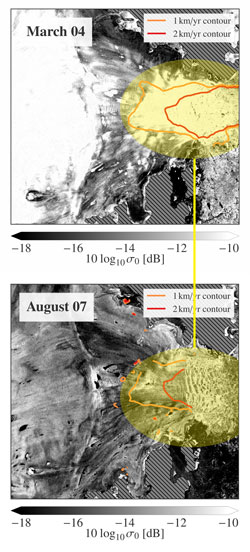
Two photos shot by ESA’s Sentinel 1-A satellite. The photos show Zachariae ice mélange gradually dissolving during the melting season. These photos relate to ‘(2)’ in the explanations of the four important factors affecting mass loss to follow (1)-(4).
1) Snow and ice melting on the surface is led to underground through cracks in the ice. During this process water functions as a ‘lubricant’. This allows the ice to move on top of the firm underground – which may lead to increased mass loss.
2) Further loss of mass originating from land based ice near the Zachariae-glacier debouche may be impeded by large quantities of sea ice and iceberg fragments.
3) The 76 kilometer long ice shelf belonging to Nioghalvfjerdsfjorden, partially functioning as a ‘cork’ in relation to land based ice moving toward the sea.
4) ‘Adhesive’ patches in the contact zone between the ice and the underground which may reduce further movement/gliding of the ice mass otherwise promoted by melt water trickling down from the surface.
By comparing charts showing surface flow-speed and computer simulations regarding ice mass movements, the researchers were able to conclude that (1) and (2) affect seasonal loss of mass to a much higher degree than (3) and (4).
The scientists point to this as an example of the importance of thoroughly investigating local processes and dynamics as a foundation for predictions regarding future mass losses from glaciers resulting in sea level rises.

Nicholas Mossor Rathmann, PhD student, Ice and Climate, Niels Bohr Institute, University of Copenhagen, Email: nicholas.rathmann@nbi.ku.dk

